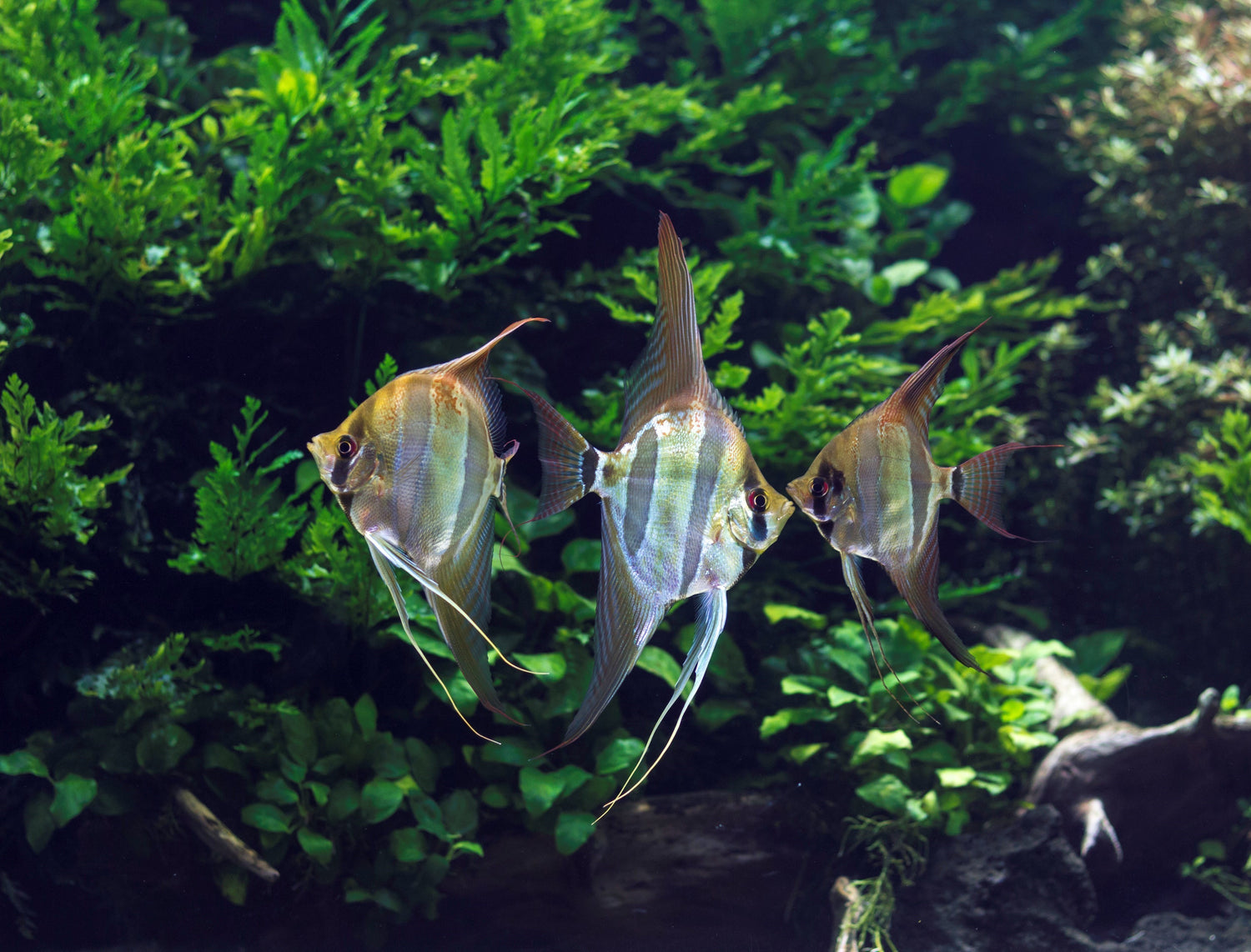Angelfish are a well-known South American cichlid with a very distinctive body shape. These fish are often used as centrepiece fish for an aquarium. They come in a variety of colours, such as white, black, striped and koi. Angelfish require great water quality and can be aggressive at times so are a good option for a fish keeper with some previous experience and a larger tank. In this article I will discuss some tips and guideline to follow when keeping and breeding angelfish.
Tank
Angelfish grow very large, they reach around 6 inches when fully grown, 30 gallons is a good starting point for one or two angelfish but consider a larger tank of around 50 gallons or more for a community setup or a group of angelfish. Angelfish also have tall bodies so care must be taken to ensure there is also enough vertical swimming space for them. In terms of the aquascape they will appreciate a mixture of open space and areas to hide. Live plants and wood will work well in an angelfish tank to offer places to retreat to, plants like Vallisneria can look fantastic in an angelfish display. Live plants will also help benefit the water quality. You will need a heater to keep the temperature around 78F - 82F. You will need adequate filtration but keep in mind angelfish prefer low flow so consider using a spray bar or aiming the filter outlet against something to reduce direct flow.
Feeding
Angelfish are not fussy eaters by any means from my experience. They will happily accept flake, pellet, frozen and live food. Be sure to feed them a mixture of foods for a balanced diet. Do not be alarmed if your new angelfish does not eat for a few days as they will need some time to settle in before starting to feed. Feed once a day. They maybe appear shy at first but eventually angelfish can become the dominant feeders within an aquarium.
Breeding
Angelfish are relatively easy to breed, if you keep a group in an aquarium, will most likely end up with a breeding pair. Male and female angelfish are very hard to tell apart, especially when they are juveniles. A lot of the time breeders can only bee 100% sure once they have seen a pair breeding. They will find a vertical area in the tank, usually a plant leaf or filter, they can lay over 100 eggs. After the eggs are laid the pair usually become territorial towards tankmates and will tirelessly chase away other fish. I have seen a pair of angelfish try to claim 80% of the space within a 40 gallon aquarium, which was not fun for the tankmates, so angelfish pair had to be moved out into another tank. Keep this in mind if you keep a breeding pair with tankmates as this may become a reoccurrence every month or so. For best results once the eggs have hatched it is a good idea to remove the fry from the parents as it can take a few litters for angelfish to know what to do. If you are serious about breeding angelfish from the get-go, consider dedicating a 50 gallon or larger tank to a group of 6 angelfish, as you raise the angelfish you will eventually get a breeding pair to focus on and you can rehouse the other angelfish.
Tankmates
Angelfish can be kept with other tropical fish and can work well in a community tank. Sometimes you may get a particularly aggressive angelfish, or they will breed and become territorial, therefore a single angelfish in a community tank can work well. Because angelfish have very long fins avoid fish that are nippy. Angelfish grow large enough to eat small schooling fish like cardinals, if they can fit in an angelfish mouth there is always a risk. Go for tall, bodied schooling fish such as lemon tetras, peaceful bottom dwellers like Corydoras and bristlenose also work well. Angelfish will eat small shrimp and other fish fry so keep this in mind when choosing tankmates.
AQUAnatur
AQUAnatur was created by an established UK aquarium installation and maintenance company near London which has been running for over 25 years! Our team are very experienced and happy to help offer advice with any aquarium questions. We are always available via phone or email Monday -Friday, feel free to contact us, we would love to help! AQUAnatur supply a range of aquariums and aquascaping products. If you have a question, please leave a comment or contact us via phone or email.
By Alasdair McPhail




Leave a comment
All comments are moderated before being published.
This site is protected by hCaptcha and the hCaptcha Privacy Policy and Terms of Service apply.